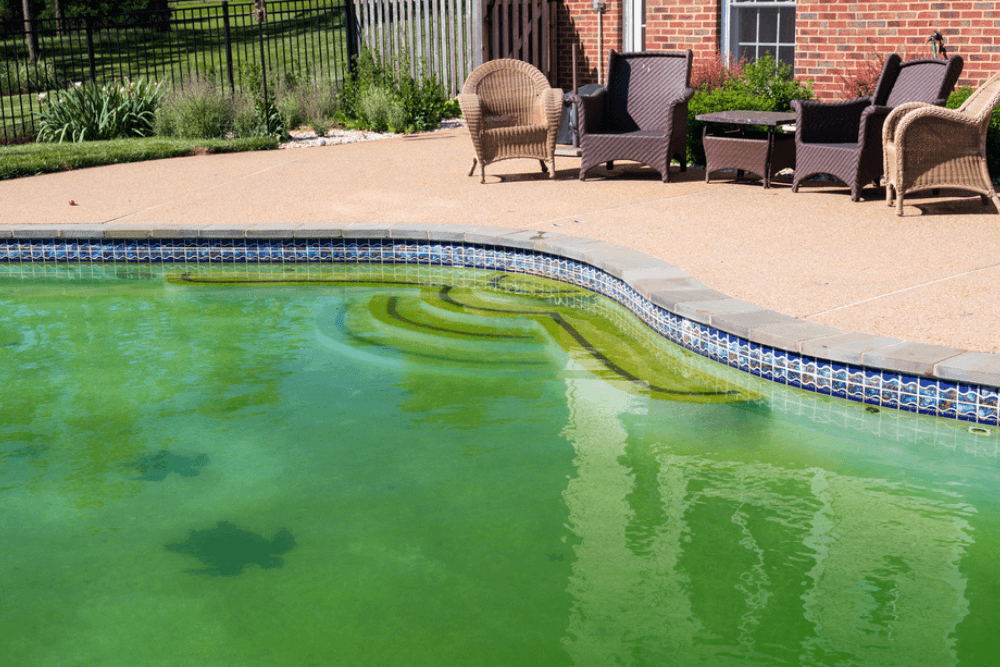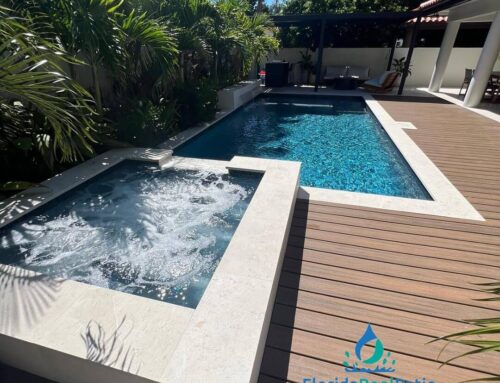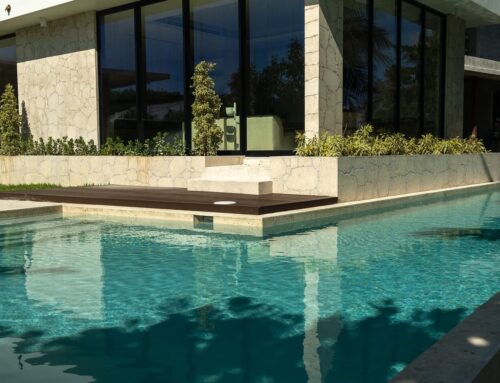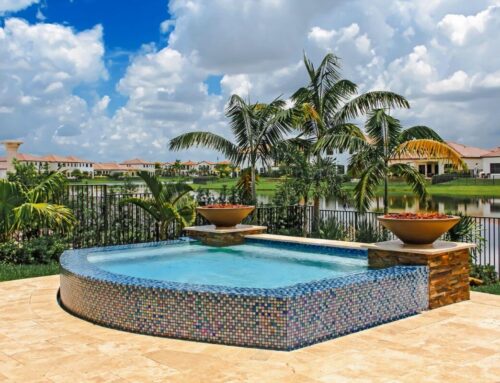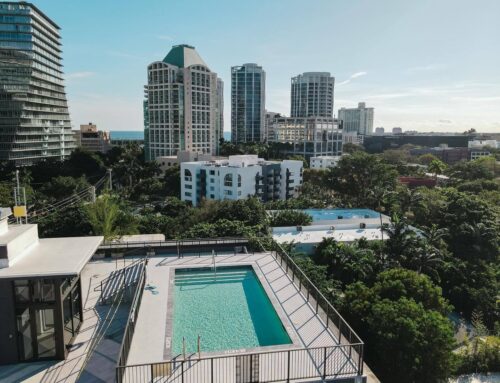A pool is a fantastic addition to any Florida home as it offers plenty of summer enjoyment and enhances the value of your property. However, the task of maintaining a luxurious swimming pool can be quite burdensome due to the significant investment it requires. Neglecting the cleaning schedule will result in the water in your pool turning green. But is it safe to swim in green pool water? Swimming in discolored water can pose risks to your health and safety.
So, what does green water indicate, and how can you resolve the issue? Discover effective tips on cleaning your pool with the assistance of the maintenance team at Florida Pool Patio.
What Causes a Green Pool Water?
The absence of chlorine is the primary cause of pool water turning green. Simply using balanced chemicals is not enough to treat discolored water. Chlorine plays a crucial role in killing algae and other unsanitary debris that can negatively impact your swimming experience. Without sufficient chlorine, algae will thrive. It’s important to note that algae can turn pool water green within a single day, especially in warmer weather. Additionally, factors such as poor water circulation, sanitation, and filtration can contribute to algae growth in the pool.
To ensure your pool remains clean and enjoyable for everyone, proper maintenance is essential. There are several reasons why your pool may lose its crystal-clear appearance or turn green, including the presence of algae, pollen, metals, low chlorine levels, high pH, or broken parts.
Algae Overgrowth
Green algae are the primary culprit for a green swimming pool. Algae, a type of single-celled plant, thrives in warm environments with ample sunlight and nutrients. Once algae find their way into your pool, they rapidly multiply and cling to the walls and steps, making your pool their new residence.
Pollen and Metals
Another potential cause of green water in your pool is pollen. Pollen, which typically has a green-yellowish color, can be easily carried by the wind and land in your swimming pool. This accumulation of pollen can give the water a greenish appearance.
Additionally, the reaction between pool chemicals and metal components, such as your pool ladder, heater, copper algaecides, and other metals, can contribute to the water turning green. It’s important to be mindful of these factors in order to maintain clear and balanced pool water.
Low Chlorine Levels
To ensure the cleanliness and safety of our pools, we maintain proper chlorine levels to sanitize the water and prevent the growth of harmful organisms, including algae. When chlorine levels are low, there is a risk that these organisms, including algae, can proliferate and take over the pool, compromising its condition. Therefore, it is crucial to regularly monitor and maintain adequate chlorine levels to keep the pool free from such issues.
High pH Levels
You can determine the acidity of your pool by measuring its pH level. If the pH reading is too high, it can hinder the effectiveness of chlorine in combating undesirable organisms. To address this issue, you can use a pH-reducing product like sodium bisulfate to lower the pH and restore the proper balance in your pool water. This adjustment will help optimize the sanitizing power of chlorine and maintain a healthy environment in your pool.
Broken Filter, or Filter Not Running Long Enough
Filters are responsible for removing dirt and debris from your pool, leaving it cleaner. If your pool starts to appear cloudy or green, it may be because you are not running the filter for a sufficient amount of time. If the problem persists, the filter could be the cause.
What Are the Different Types of Green Water?
There are three types of green water that can be found in swimming pools: light, dark, and black.
- Light green: You are most likely dealing with a minor pool algae issue. A low level of pool sanitizer and poor maintenance can cause the water to turn light green.
- Dark green: The darker the color, the more algae you have in your pool. Algae with darker green tones are more problematic. If your pool water is dark green, you will need to spend more time cleaning it.
- Black green: This type of water is the most severe. Your pool will appear dark green and is likely infested with algae. The algae in this case are highly resistant to cleaning and difficult to remove. They can leave stubborn stains on your pool’s walls and floor.
Is Swimming in Green Pool Water Dangerous?
Can you and your family have fun in a pool with green water? The answer to this question depends on the color of the water in your pool. Algae are essential for aquatic life in natural bodies of water, such as lakes and ponds. However, in swimming pools, the water becomes less safe as it darkens. Swimming can become dangerous due to the presence of bacteria like E. coli, which can be found in algae.
Moreover, the presence of algae in your pool can cause damage. This means you will have to spend money on repairs. Algae can clog the pool filter, rendering it ineffective. Additionally, algae can stain the surfaces of the pool, leaving unsightly marks that are difficult to remove. To combat green pool water, it is crucial to ensure that your pool is properly balanced and perform regular cleanings.
How Do You Clean a Green Pool?
It is easier to clean a pool that has light green water than one with dark green. Both can produce the same results.
Step 1. Remove Any Large Debris or Materials From the Pool
You may notice algae or debris at the bottom of your pool or floating around. It is important not to stir the water, as this can exacerbate the issue. If you are unable to see the bottom of the pool, avoid using a vacuum. You don’t know what might be at the bottom, and using a vacuum could potentially damage or clog the filter. If there is still debris present in your swimming pool, repeat the necessary steps to address the issue.
Step 2. Adjusting the Water’s PH Levels
The ideal pH for pool water is 7.5, but if you are cleaning a dirty swimming pool, aim for 7.2. You can lower the pH of the water by using sodium bisulfate.
Step 3. Shock the Pool
Add some chlorine to your pool’s water if you want it to be free of algae. To instantly kill bacteria and algae, add shock into your pool. You will be given instructions with the shock product that you purchase on how to add it to your pool. Test the water after an hour or so to check the level of chlorine. The level of chlorine should be between 5-10 parts per million (ppm). You can also use the test strips to determine the level of chlorine.
Step 4. Pump & Filter the Water
After shocking the water in your pool, turn on your pump and let it run for a day. This will help distribute the chlorine evenly throughout the water. Within 24 hours of shocking your pool, you should notice a significant difference. The pool water may appear cloudy due to floating dead algae.
Keep the pool pump running and use a pool brush to clean the walls and floor of the pool. If there is algae stuck to the surfaces, you can use a vacuum and brush to remove it. During the shock process, remember to clean your vacuum bag and filter it multiple times.
Step 5. Test for Chlorine Loss
After shocking the pool, be aware that the chlorine level can decrease again if there are remaining algae or if the pool is exposed to sunlight. It is important to regularly monitor the chlorine levels. You can consider the pool ready when the chlorine level remains consistent for a couple of days or drops by just 1 point.
Conclusion – Is It Safe to Swim in Green Pool Water?
Swimming in green pool water is generally not safe and is not recommended. The presence of green water indicates a high concentration of algae or other microbial growth, which can pose health risks to swimmers. Algae can cause skin and eye irritations, respiratory issues, and may even harbor harmful bacteria or parasites.
Additionally, the green coloration can hinder visibility, increasing the likelihood of accidents or injuries. It is crucial to prioritize the safety and well-being of individuals and maintain proper pool hygiene by regularly treating and maintaining the water’s cleanliness. If you encounter a green pool, it is best to refrain from swimming until the water is properly treated and restored to a clear and balanced state.
Let Florida Pool Patio Handle Your Pool Repair and Maintenance
Experience the difference with Florida Pool Patio, your trusted partner for pool repair and maintenance. Our team of experts is dedicated to providing top-notch service and ensuring your pool is in pristine condition year-round. From minor repairs to comprehensive maintenance plans, we have you covered.
Say goodbye to the hassle of pool upkeep and let us handle it for you. With our meticulous attention to detail and commitment to excellence, you can relax and enjoy your pool without any worries.
Contact Florida Pool Patio today and let us take care of all your pool needs. Your oasis awaits!

